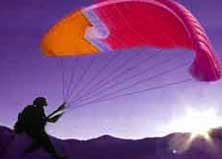| Paragliding An Introduction
|
|||||||||
The training begins with a briefing on the para glider with everything described in great detail for novices to familiarise themselves with the equipment and it's functions. A glider can be folded in 10 minutes and weighs less than 7 kilos. It is easy to transport, easy to launch, and easy to land. A paraglider is a non-motorized, foot-launched inflatable wing. It is constructed from a specially designed square parachute of rip-stop nylon coated with polyurethane to ensure zero porosity. The canopy is constructed of a top and bottom surface joined by a number of vertical segments. The resulting chambers are called the cells. The opening at the front is called the leading edge. When the canopy is fully inflated, the cells take up an aerofoil shape with a somewhat fat lower surface and a curved top surface. The rear of the wing is usually called the trailing edge. |
Paragliding • Tandem Paragliding • Strangers To Earth • Paragliding in India
Adventure activities | ||||||||
As in most adventure sports, paragliding can be as safe or dangerous as you make it. Learning should be in as controlled an environment as possible. But paragliding is still an outdoor sport in which you are trying to harmonise with the forces of nature and your personal judgment and attitude are of fundamental importance. You must be willing to learn gradually. Physical and mental alertness are imperative. To be a successful paragliding student and pilot, you need to be able to think clearly and to listen well.
Paragliders are light and aerodynamic and are designed to go up rather than down. . With a paraglider, you actually fly like a bird, soaring upwards on currents of air. Paragliders routinely stay aloft for 3 hours or more, climb to elevations of 15,000', and go cross-country for vast distances. The launches and landings are slow and gentle and, once airborne, the experience can be serene, quiet and peaceful.
|
|||||||||
Editor: Romola Butalia (c) India Travelogue. All rights reserved. |
|||||||||
 The programme includes dry runs which is launching practice on gentle slopes, followed by small hops which are low flights with ground clearance of a few feet, before embarking on longer and higher flights. Paragliders launch from gentle hillsides with their gliders already opened for flight. If the glider isn't flying properly, the launch can be aborted before leaving the ground. . The basic techniques of paragliding - launching, turning and landing are fairly easy to learn.
The programme includes dry runs which is launching practice on gentle slopes, followed by small hops which are low flights with ground clearance of a few feet, before embarking on longer and higher flights. Paragliders launch from gentle hillsides with their gliders already opened for flight. If the glider isn't flying properly, the launch can be aborted before leaving the ground. . The basic techniques of paragliding - launching, turning and landing are fairly easy to learn.